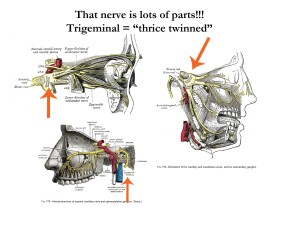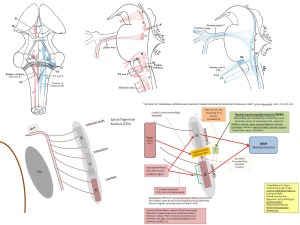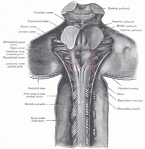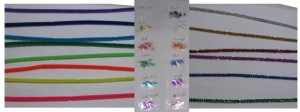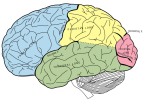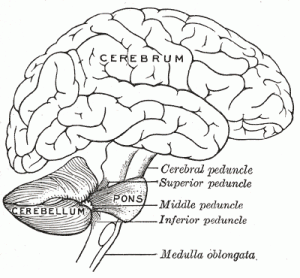Last update line to this post (7/13/12). The summary is that I got started on making the first piece of my model and found something new that I needed to include as a design principle.
As of 6/4/2012 this is an unfinished post! Since it is a creative work in progress on exactly how I turn brain information into a piece of art, I thought there might be preliminary interest before I was finished. It’s also nice having a record of the process for my own benefit 🙂
Most recent update
6/20 I Have Dye!
I’m almost done with the Legend. My next steps are to Finish the Legend, revisit the material briefly, and sketch the piece. I should be deliberate about this too. Even though the parts are easy, I want to do them right.
Note: My intentions are to update a couple of times and then make a final post.
6/5 update: Added the final decision on a trio of ganglia and the logic from source A1
6/7 update: Complication due to ambiguous structure, and doing figures right the first time. Below…
6/8 Finalized the method of diagramming the in-put/out-put logic! I think it’ MUCH cleaner and more understandable.
6/10 The weekend is a time for mentally resetting. This is valuable. I want to explain this someday 🙂 Essentially I need to add a new major element to the design so things got a bit slow while I was thinking. Now I have a solution!6/19
6/12 My apologies on the lack of updates. I have to order a black dye that I can use in the plastic so it might be a few days…
I’ll get some figures into this post. (…and yes I realize that I put beads into my figures twice…)
6/18: The dye will be here today hopefully. That would let me start tomorrow. This stuff has been designed in my head for over two weeks now and I’ve been going a bit nutty wanting to start. But the wait was worthwhile though because a legend page is a great idea. This one is turning out kind of neat because it’s like a lab meeting for you guys like the kind I used to always do during graduate school. A lot more fun than the real ones of course! (Unless the science is fun even when drier like it is for me 😉 )
6/19 I have no dye. Otherwise this will be the best map legend ever, or it will be horrible:) I’m at 3049 words and really enjoying myself.
***************************************************************************************************************************************************
Now hopefully I can get a routine down to get this thing going in earnest! This will be the day to start good patterns and habits.(This will please you if OCD, maybe…)
Create a routine and just do one for now and as long as necessary. In fact that is what I am doing here. Blogging the experience of my first research attempt on my first model piece so that you can get an idea about the level of detail, and the thinking processes that I was engaging in while I was figuring out what I needed for every piece so that I can say the info is “GOOD”. It’s a model for the following work that I can refer to for anyone who is curious.
For every one of these brain processing centers I need the following information:
- The logical decision that it makes/role that it takes.
- Every known structure that it connects to.
- The logical nature of each of those connections (activation, inhibition, etc…).
- The number of connections (if possible, it might be important).
- The ultimate beginning and nature of the information that it carries/conveys. (For this and #6 it is to keep us in the “big picture both functionally, and experience-wise”)
- The ultimate end and nature of the information that it carries. (See #5 for context)
- Known Epigenetic regulation (for future use)
- What it looks like (might as well have some more context…).
For most readers 1-6 are of decreasing importance. 7 has to do with cutting edge things that are so new I can’t really do more than book mark it so I can build something into the model later when my brain spits out visual solution that is sensible in the information hierarchy. 8 will be useful to people in medicine or brain science. They will be more likely to have a mental link to the shape and it will be more interesting.
Of course I will add more as necessary, but that should be a good place to start. I have a system, I have a plan, what is the first piece!
#1 Spinal Trigeminal Nucleus
From Yahoo. Thank’s yahoo! (Trigeminal = “thrice twinned”. The freaking root is the “nerve”. Nerve is one of the most abused words in science. Its a linguistic whore…
Interesting context though. I almost feel like I’m in the room with Grey…
Looks I have a more challenging piece for my first attempt. I like to Wikipedia first as a broad overview and it says,
The spinal trigeminal nucleus is a nucleus in the medulla that receives information about deep/crude touch, pain, and temperature from the ipsilateral face. The facial (cranial nerve 7), glossopharyngeal (CN9), and vagus nerves (CN10) also convey pain information from their areas to the spinal trigeminal nucleus.[1]. Thus the spinal trigeminal nucleus receives input from cranial nerves 5,7,9,10.
This nucleus projects to the ventral posterior medial nucleus in the dorsal thalamus.
That’s pretty bare for Wikipedia so either its pretty simple, or there is not much work with it yet. On top of that the source is gone. Would you trust that? The talk page just leads to a general medical portal, and the revisions just get simpler. This is when I start going to Pubmed, but later because this is a good example of what I keep running into when studying brain info:
Lack of specificity: Due to the long and complicated nature of brain research, this article uses historical Grey’s Anatomy images. This image is only useful when combined with other information because when Grey first did this work he numbered the cranial nerves I-XII, and their root ganglia I-XII. Since then they have discovered that these nuclei are more complicated than they thought because these nerves carry motor, sensory, place-in-space and other information from different places and for different purposes! So the Wikipedia page lists 12 cranial nerves, but 24 cranial nerve nuclei that translate and pass on the information. Annoying! The history has value, but that value is relative to the public’s utility. As long as the ultimate purpose of telling the history is honored in education (or fun), the information needs to be reorganized by everyone in biological sciences.
The Trigeminal Nerve, A TL;DR history.
It’s interesting that my first nuclei is actually mostly not about the body despite being at the bottom of the brain (or at least very low and central to the brain stem structure). That might say things about how human segments are arranged. In fact I think it suggests that the brain stem, should actually be thought of as the “Brain’s Spine”, combined with the information transfer of the “Body’s Spine” So the general information flow in the head looks like this…
…so far. In fact I think that a diagram of the information flow will be a necessary part of this project and I will draw one as I go. Fortunately Wikipedia even helps me here!
- Outline of Human Anatomy: Nervous system part That and grey’s anatomy will let me diagram all the sensory and motor and “other” (My favorite part!) information flow!
- If I have trouble with the nerves I can compare with the known circulatory system routes since the nerve will come off of a segment that also produces a vein/artery pair!
The brain stem is actually an interestingly complicated structure that literally routes information that impacts your entire body. It’s the most important information routing intersection in terms of overall structure at a “horror movie” or “that’s disturbingly interesting” level. So it’s actually a nice contrast that this structure has a complicated history when it comes to learning about it, and it being the first piece I make.
It was named as it looks, and the most obvious feature a centuries old anatomist would notice is that there are three huge nerves splaying from the cut zone. So yeah the old folks do the best with names that they can. The Trigeminal Nerve is interesting to me because the details of the information it handles shows us just how the “Human Worm Segments” of our head are arranged in gross detail.
Using Wikipedia on 6/4/2102, The nerves that feed this structure information mostly have to do with the face on the opposite side of the axis from the ganglion. But that information can be divided into two groups:
- Information about “…deep/crude touch, pain, and temperature from the ipsilateral face.”
- Physical routing of pain information from “The facial (cranial nerve 7), glossopharyngeal (CN9), and vagus nerves (CN10) also convey pain information from their areas to the spinal trigeminal nucleus.[1]. Thus the spinal trigeminal nucleus receives input from cranial nerves 5,7,9,10.” (We will see this link a lot. I will have to make a Link archive. I have to add proper citations to my routine anyway…)
The output is to the:
There’s that language again. Remember this old thing?  I will need to make a new version with some more terms…
I will need to make a new version with some more terms…
Ipsilateral means “same side”, Contralateral means “opposite side”. I think the entire reason that the brain does the side switching thing with information is to create a “Logical Contrast” so that it can tell a difference.
So we have the more “primal” type of pain, touch, and temperature from the face.
In addition we have unspecified pain information traffic for the face (facial nerve, “face/mouth nerve”), the mouth/throat(Glossopharyngeal nerve, “tongue-throat” nerve), and one of the most important nerves in your body, the Vagus nerve. Just pain information.
All that chaos above tells us that the ordered structure that we see in almost every human (there will always be exceptions) has rules, but we don’t understand them. So to properly understand the human body absolutely (if you are into that kind of thing) involves knowing the rules of the growth of the structures. That’s right, embryology.
Oh boy! A new toy! …and some old ones…
I know almost nothing about embryology, but the reason I am willing to play in an unfamiliar field is because I have enough experience with the fundamentals, and would have no problem internalizing a few new basic principles like the diffusion of chemicals in an embryo. (Sorry folks, it’s not a miracle. It’s only complex, which is why all the pain and suffering pops up too often.)
If you can see the results…
…you can get conceptual hold of any topic.
and
Now I’m only going to include the bits relevant for us, but when development becomes important for functional understanding, I will bring it up. I guess in general I will need a couple of recent reviews on the structure/ganglia/nuclei mass just to make sure I have everything. I always try more than one kind of search so I don’t bias myself so I am trying (I already warned you there are cultural effects in the science and the medicine of the Brain/Mind).
A. [Spinal and trigeminal and nucleus], B. [Trigminal and Nerve]. 272, and 1680. That difference is due to the fact that one plugs into another, time, and because doctors don’t see a STN, they something that their intellectual ancestor called something like a “..special nucleus of gray substance…”, which is to say they don’t see a computer, they see meat.
For A, Sorted by date
- “The role of trigeminal interpolaris-caudalis transition zone in persistent orofacial pain.” is the most recent review that is really “meaty” and detailed. A
- “Neurochemical properties of the synapses in the pathways of orofacial nociceptive reflexes.” is a more “molecular/cellular/tissue angle. Not a review, but they will have background. It’s the kind of thing that I could actually explain if anyone was curious. I used to do something called “In-situ Hybridization” and it was fun! I made yeast cells glow red and blue and genetically modified the creature myself. Life can be legos sometimes. Although I have to assemble it myself with Word and screen grabs…
- “Anatomy of the Rostral Nucleus of the Solitary Tract.” A book chapter. I love these people. Not the same nucleus but also in the brainstem so will give context. More screen grabs…
For B
- This one is Meaty and fun if you have the stomach. A review investigating new scanning technology on a live patient! This is the benefit of broadening your search criteria on anything. Let your tastes guide you.
- “Non-Invasive Mapping of Human Trigeminal Brainstem Pathways” is the brainstem relevant, uh yeah… more Word and screen grabs though…
- If I need one after the fun stuff above…
I think that is a good start so Now I read and diagram out a mini logical structure of the region of the general Trigeminal nerve nuclei, out one heirarchy level from the the Spinal Trigeminal Nucleus. I have defined my artistic link to the brain…
6/5/2012
After reading “The Role of Trigeminal Interpolaris-Caudalis Transition Zone in Persistent Orofacial Pain” (A1 above) I have come to the conclusion that I must have a nod to actual structure in the model. But how to do this and not have it overwhelm the computation? I may just do it in metal wire that I can paint with a UV reactive substance so you can see the structure “light-up” over the computer bits…
The rear/bottom part of the STN is the Vc (Nerve V, caudal nuclei) This does the pain and crude touch part of this nucleus. It will be Yellow plastic with Black and Red glitter. The logic of the connections that I could strip out of “The role of trigeminal interpolaris-caudalis transition zone in persistent orofacial pain.” is in this image. Looks like I’m building in interesting trio and then attaching the group!
6/7 Update
So where is that model piece you promised!
The reason this was done in a pseudo-“live blog” was that I knew complications would arise and that I would need adjust things. I am prone to internalizing bad habits. It take effort for me to get a bad routine out of my head and I love routines! So with something as long term and detailed as this I need to get it right early. So what is at issue?
- That really shitty diagram above
- ambiguous structures.
One is easy but it took me some time yesterday to think it through. I decided to take the Grey’s anatomy images and convert them to figures in Microsoft PowerPoint (you can do SO MUCH with MS office and Photoshop. Did you know you can copy/ paste from one to the other in many cases?).
That still needs some work but is MUCH better than the previous. Still too busy for most readers, but better for now.
Two is a little harder. When I read that first source and discovered this Vi/Vc transition zone, I discovered that it was a very important network hub for a lot of important processes, and it’s still being intensely studied. So while this model is really adaptable to having elements replaced, I need a way to present things like this transition zone. I am working on the second source above (“Neurochemical properties of the synapses in the pathways of orofacial nociceptive reflexes.”) and it includes even MORE extra info about this same transition zone! I hope to have that integrated by the end of the day, after I figure out how to present this hub of a transition zone. It’s more fun than frustrating, but when I say I am going to do something I need to be more specific to your guys…
6/8
Final method of showing the in-put/out-put logic! Three separate diagrams for each of inputs, outputs, and “unknown logic”
Next, and hopefully last before modeling something, how do I show these extremely important inter-ganglial transition regions? They are extremely important apparently! Look at all those outputs! I need a way to make them seem obvious when differentiated from the ganglia proper, but still related to the functional class…
6/10 Post one.
I think having a period where you just have fun and relax will one day be a constitutional right if we can define it. Chances are when I am done here we will discover that creativity as a process requires spacing and thinking. The more employers dump on employees, the more mental reset points will probably be necessary. This would probably be to ensure that the physical basis of practice and more importantly, internalization is achieved under the least stress. You can take that as a scientific hypothesis…
To make up for the weekend gap I am now adding a “Legend Page” where the design elements will be explained in specific terms, and the way the elements interact will also be explained so that you can understand how the picture becomes the data that create our experience. In general terms at least. Since science will always be adding to what we know about ourselves, this model is by design extremely easy to alter by nature. It’s an expression of the scientific method.
Here is a preview since it is still in progress. I hope I “code in” permanent elements today at the very least.


